How to Choose the Right Type Of Air Conditioner
Choosing the right air conditioner can make a noticeable difference in comfort and energy use during Australia’s warm months. Each type of air conditioner: central, ductless, window, or portable, offers unique benefits suited to different homes and climates. Understanding the main types of air conditioners helps identify which system best fits a space, budget, and cooling needs.
Modern systems go beyond basic cooling. From hybrid and dual fuel models that balance efficiency with performance to evaporative coolers ideal for dry regions, technology continues to expand the options. Smart and inverter air conditioners also bring improved control and energy savings, making temperature management more precise and cost-effective.
Knowing how each type of air conditioner works allows homeowners to make confident decisions before investing. The following sections explore the most common air conditioner types, how they operate, and when each one makes the most sense for Australian homes, helping you choose the right air conditioning system.
Central Air Conditioners
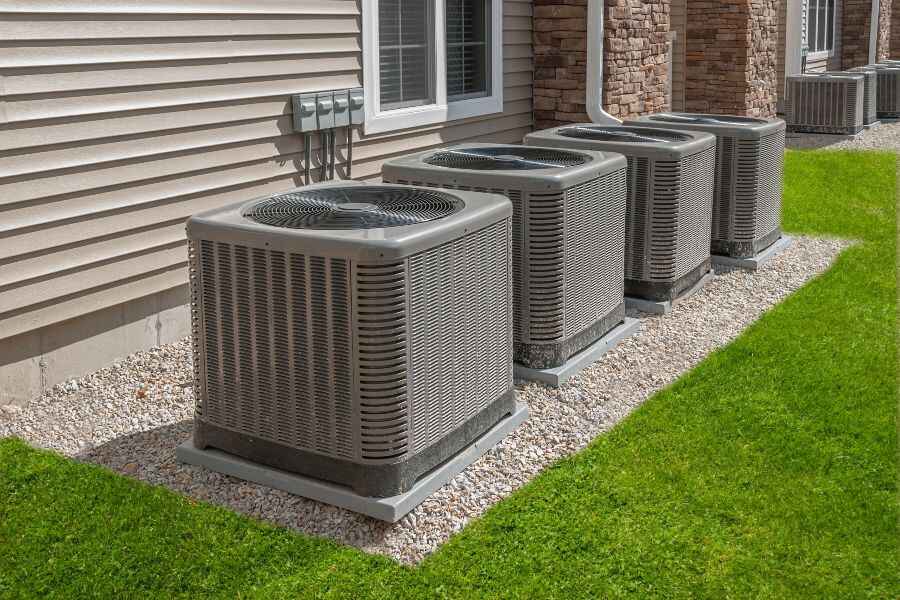
Central air conditioning systems cool entire homes through a network of ducts and vents that evenly distribute conditioned air. These systems vary in design and installation, with differences in how components are arranged, maintained, and suited to different property layouts.
Split-System Central Air Conditioners
A split-system central air conditioner separates the cooling components into two main units. The outdoor unit houses the compressor and condenser coil, while the indoor unit contains the evaporator coil and air handler. Refrigerant lines connect the two, transferring heat from inside to outside.
This configuration suits homes with existing ductwork and offers efficient cooling for multiple rooms. Technicians can service each component separately, which often reduces air conditioning system repair complexity.
Many models feature inverter compressors that adjust output based on demand, improving energy efficiency and temperature stability. This system typically provides quieter operation than packaged units because the compressor sits outdoors.
However, installation costs can be higher due to the need for both indoor and outdoor units and proper refrigerant line placement. Regular maintenance of filters and coils helps maintain performance and extend system life.
Packaged Central Air Conditioners
Packaged systems contain all major components: compressor, condenser, and evaporator, within a single outdoor cabinet. The unit usually sits on a concrete slab beside the home or on the roof. Ducts run from the cabinet into the building to circulate conditioned air.
This design simplifies installation, making it common in smaller homes or buildings without space for an indoor unit. Because everything is housed together, technicians can access components easily for servicing.
Packaged air conditioners can include optional heating elements or gas furnaces, allowing one system to handle both cooling and heating. While convenient, these systems may lose some efficiency compared with split systems due to outdoor exposure and potential heat loss.
Noise levels can be higher since all mechanical parts operate outside in one enclosure. Proper sealing and insulation of ducts help maintain energy efficiency.
Ducted Air Conditioning Systems
Ducted air conditioning distributes cooled air through a network of insulated ducts hidden in ceilings or walls. A central indoor unit connects to a series of vents that deliver air to each room.
This setup provides consistent temperature control and is well-suited to large or multi-room homes. Zoning controls can divide the system into separate areas, allowing users to cool specific rooms independently and reduce energy use.
The ducts require careful design to ensure balanced airflow and minimal leakage. Poorly installed ducts can lead to uneven cooling and higher running costs.
Maintenance includes cleaning filters, inspecting ducts, and checking for insulation damage. When properly installed, ducted systems offer discreet, efficient operation and maintain a clean interior appearance.
Install Once, Enjoy for Years
Why wait to enjoy cooler rooms and lower power bills? We design and install air conditioning systems tailored to Australian homes. Contact us today – 0480 808 422
Ductless Mini-Split Air Conditioners

Ductless mini-split air conditioners provide targeted cooling and heating without the need for ductwork. They connect one or more indoor units to an outdoor compressor through refrigerant lines, offering flexible installation and efficient temperature control in specific areas of a home or building.
Single-Zone Mini-Splits
A single-zone mini-split system uses one indoor air handler connected to one outdoor unit. This setup suits rooms that need independent temperature control, such as home offices, studios, or extensions without existing ducts.
These systems typically range from 2 kW to 8 kW in cooling capacity. Because each zone operates separately, users can adjust the temperature without affecting other parts of the property.
Installation is relatively simple and often requires only a small wall opening for refrigerant and electrical lines. Many models include inverter compressors, which modulate power to maintain consistent temperatures while reducing energy use.
Single-zone systems are ideal for improving comfort in areas where central air conditioning may be inefficient or impractical. Their compact design and quiet operation make them a preferred option for both residential and small commercial applications.
Multi-Zone Mini-Splits
A multi-zone system connects multiple indoor units to a single outdoor condenser. Each indoor unit serves a separate area, allowing individual climate control for different rooms.
This configuration supports two to eight zones, depending on the system’s capacity. It helps balance temperature differences across large or multi-level homes. Each zone can be programmed independently, improving comfort and reducing energy waste in unused spaces.
Multi-zone systems cost more upfront than single-zone models but offer long-term savings through reduced energy consumption. They also minimise the need for extensive ductwork, which can reduce heat loss and installation time.
Common indoor unit types include wall-mounted, ceiling cassette, and floor-standing options, allowing flexible placement to suit interior layouts.
Wall-Mounted Units
Wall-mounted units are the most common indoor component of ductless systems. Positioned high on a wall, they distribute conditioned air evenly throughout the room.
These units feature adjustable louvres that direct airflow and maintain consistent temperatures. Many include washable filters and remote controls for easy operation.
Installation requires minimal space, making wall-mounted units suitable for apartments, offices, and bedrooms. Their slim profiles blend with most interiors while keeping maintenance accessible.
Energy-efficient models often include variable-speed fans and smart sensors that detect occupancy or temperature changes, further improving comfort and efficiency.
Window Air Conditioners

Window air conditioners provide a self-contained cooling option that fits directly into a window or a specially designed wall slot. They suit small to medium rooms and offer a straightforward installation without the need for complex ductwork or multiple components.
Standard Window Units
Standard window units are the most common type of window air conditioner. They combine all components: compressor, condenser, expansion valve, and evaporator, into one box that sits partly inside and partly outside the window frame.
These units are ideal for rooms between 10–30 square metres, depending on capacity. They are often rated between 1.5 kW and 6 kW, providing effective cooling for bedrooms, studies, or small living areas.
Installation usually requires a single-hung or double-hung window. The unit’s rear expels hot air outdoors while the front circulates cooled air indoors. Most models include adjustable louvres, washable filters, and remote controls for convenience.
Maintenance involves cleaning the filter every few weeks and checking for unobstructed airflow around the outdoor vent. While affordable and easy to replace, these systems can produce moderate noise due to all mechanical parts being housed together.
Slider/Casement Window Units
Slider or casement window units are designed for vertical or horizontal sliding windows where standard models do not fit. They are taller and narrower, allowing installation in non-traditional window openings often found in apartments or older homes.
These models typically offer cooling capacities from 2 kW to 5 kW. Their installation may require a mounting kit or side panels to ensure a secure seal and prevent air leakage.
Because of their shape, airflow direction and efficiency differ slightly from standard units. Users should ensure the exhaust vent remains clear and the unit is level to allow proper drainage.
They cost slightly more than standard models but provide a practical solution for homes with limited window options or unique architectural layouts.
Safety You Can See
Replace aging fuses with our electrical switchboard upgrade; modern RCD protection, surge devices, and a clearly labelled board. We deliver a clean, compliant result you’ll feel confident about. – 0480 808 422
Portable Types of Air Conditioners
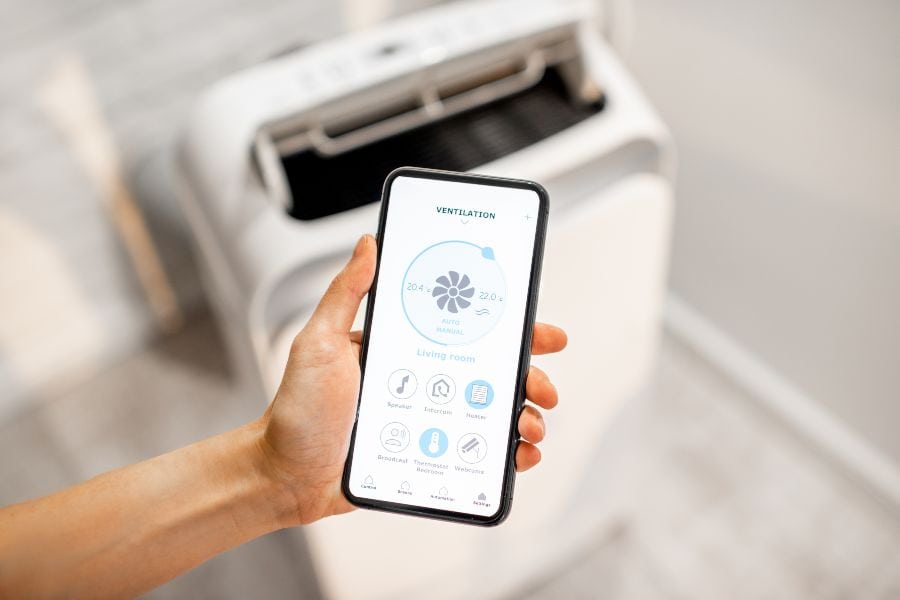
Portable air conditioners are types of air conditioners that provide flexible cooling for spaces where installing a fixed unit is impractical. They use a vent hose to expel warm air through a window or vent kit and typically include wheels for easy movement between rooms.
Single-Hose Portable Units
A single-hose portable air conditioner draws air from the room to cool its internal components, then releases the heated air outdoors through one exhaust hose. This design makes it compact and easy to install, suiting small rooms or temporary setups.
However, using indoor air for cooling can create a slight negative pressure. Warm air from adjacent spaces may enter the room, which can reduce cooling efficiency in hot weather.
Key characteristics:
- Airflow: Uses indoor air for cooling.
- Installation: Simple, requiring only one hose and a window kit.
- Efficiency: Generally lower than dual-hose models.
- Best for: Smaller rooms or renters needing a quick setup.
These units are often more affordable and lighter, making them practical for short-term or seasonal use.
Dual-Hose Portable Units
A dual-hose portable air conditioner uses two separate hoses: one to draw in outside air and another to expel hot air. This system prevents negative pressure and allows faster, more consistent cooling.
Because it relies on outdoor air for cooling, the unit operates more efficiently in sealed rooms. It also reduces the strain on the compressor, which can extend the unit’s lifespan.
Key characteristics:
- Airflow: Draws and expels air through separate hoses.
- Installation: Slightly more complex but still portable.
- Efficiency: Higher cooling capacity and faster temperature control.
- Best for: Larger rooms or frequent use where energy efficiency matters.
Although dual-hose models often cost more, they deliver better performance and maintain room comfort more effectively.
Hybrid and Dual Fuel Types of Air Conditioners
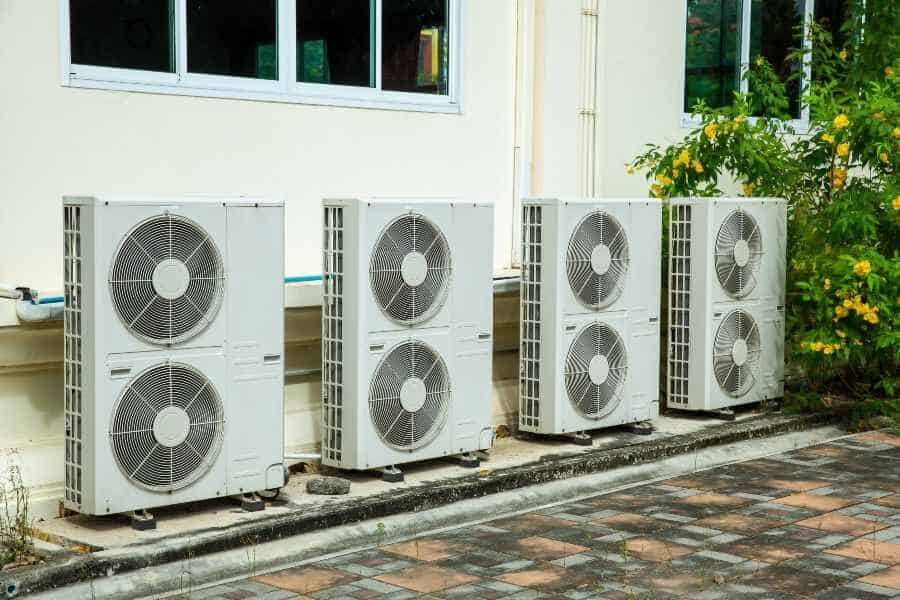
These types of air conditioner systems combine multiple energy sources to improve efficiency and reduce operating costs. They adjust how they heat or cool a home based on outdoor conditions and energy prices, offering flexibility that standard units cannot.
Hybrid Split System Air Conditioner
A hybrid split system uses both electricity and another energy source, often gas, to manage heating and cooling. It usually includes a heat pump paired with a gas or oil furnace, connected through a shared duct network.
The system automatically selects the most efficient energy source. For example, it may use the electric heat pump during mild weather and switch to gas heating when temperatures drop. This balance helps maintain comfort while reducing energy consumption.
Key components include:
- Electric heat pump: Provides cooling and moderate heating.
- Gas or oil furnace: Supplies heat in colder conditions.
- Thermostat controller: Manages energy source switching.
Homeowners benefit from lower running costs and reduced emissions compared to conventional systems. However, installation costs are higher, and performance depends on proper sizing and climate conditions.
Dual Fuel Systems
A dual fuel system integrates a gas furnace with an electric air-source heat pump in a single HVAC setup. It monitors outdoor temperatures and automatically switches between fuels to maximise efficiency.
When the weather is mild, the heat pump handles both heating and cooling. As temperatures fall, the gas furnace activates to provide stronger, faster heating.
Advantages:
- Improved energy efficiency
- Reduced reliance on one fuel type
- Consistent indoor comfort
Considerations:
| Factor | Description |
| Climate suitability | Performs best in regions with variable temperatures. |
| Installation cost | Higher than standard systems, but offset by energy savings. |
| Maintenance | Requires servicing for both electric and gas components. |
This setup suits households seeking efficient, adaptable temperature control across Australia’s varied climates.
Evaporative and Swamp Air Conditioner Types
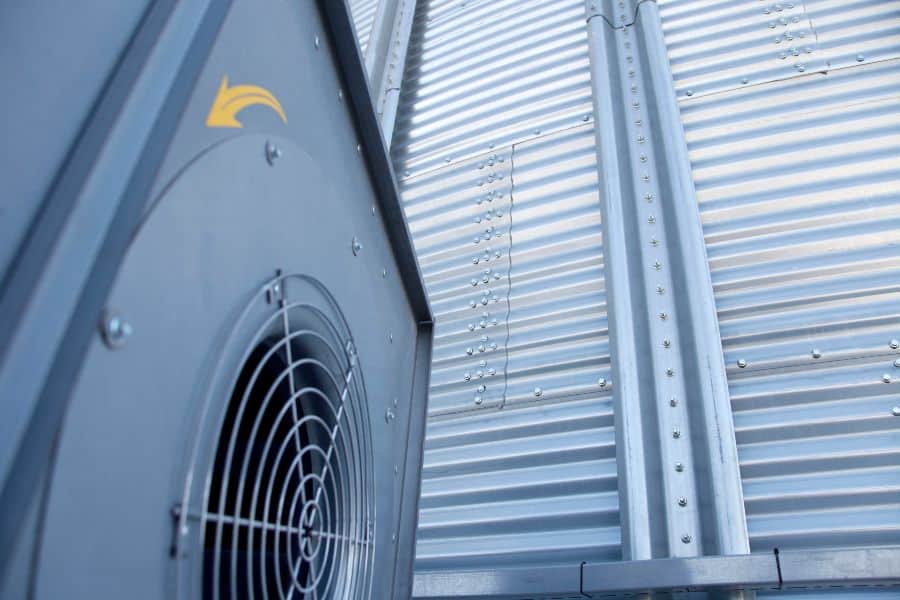
Evaporative and swamp coolers are types of air conditioners that use water evaporation to lower air temperature, offering a low-energy alternative to traditional refrigerant-based systems. They perform best in dry climates and provide fresh, filtered air while consuming less electricity than conventional air conditioners.
Direct Evaporative Coolers
A direct evaporative cooler draws warm outdoor air through wet cooling pads. As the air passes through, water evaporates and absorbs heat, releasing cooler, more humid air into the living space. This process works without compressors or refrigerants, reducing both energy use and operating costs.
These systems are most effective in dry regions where humidity levels remain low. In humid conditions, their cooling capacity drops because the air cannot absorb much additional moisture.
Maintenance involves regular air conditioning cleaning and pad replacement to prevent mineral build-up and maintain efficiency. Direct coolers also require a steady water supply, but their water consumption is modest compared to the energy savings achieved.
| Feature | Description |
| Cooling method | Evaporation through wet pads |
| Best climate | Hot and dry |
| Energy efficiency | High |
| Added humidity | Yes |
Indirect Evaporative Coolers
An indirect evaporative cooler uses a heat exchanger to separate the humid airstream from the cooled supply air. This design prevents added moisture from entering the indoor environment, making it suitable for areas with moderate humidity.
The system cools air in two stages: one stream is cooled by evaporation, and the other absorbs heat through the exchanger. This method delivers cooler, drier air than direct systems while still avoiding refrigerants.
Indirect coolers cost more to install but offer greater comfort control and broader climate suitability. They require slightly more energy than direct models but remain significantly more efficient than compressor-based air conditioners.
Smart and Inverter-Type Air Conditioners
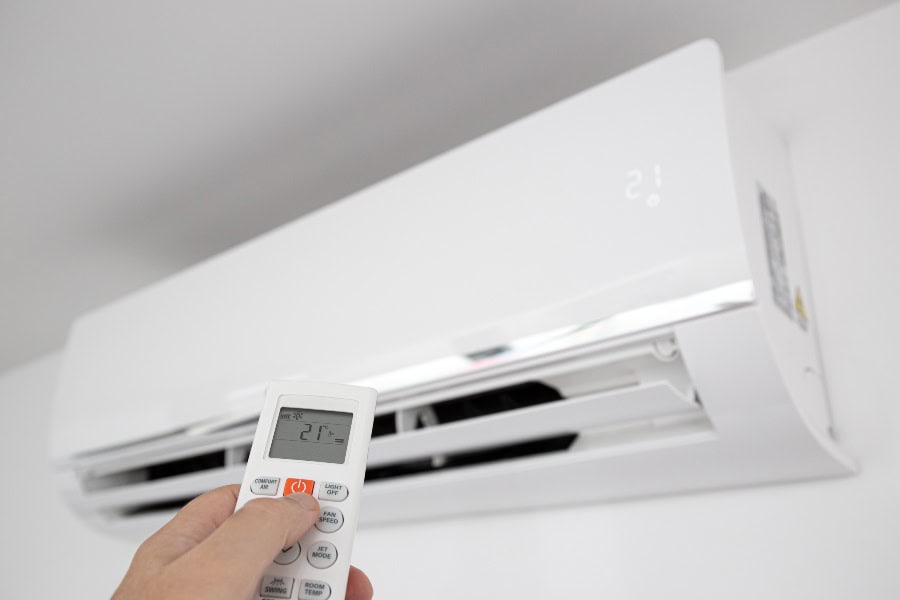
Modern types of air conditioners combine energy-efficient compressors with digital connectivity to improve comfort and control. These systems reduce power use, maintain stable temperatures, and allow users to manage settings remotely through mobile devices or smart assistants.
Wi-Fi Enabled Air Conditioners
Wi-Fi-enabled types of air conditioners connect to home networks, allowing users to adjust temperature, fan speed, and mode through smartphone apps. Many models also integrate with Google Assistant, Amazon Alexa, or other smart home platforms for voice control.
Owners can monitor energy use, set schedules, and receive maintenance alerts. This remote access helps reduce unnecessary operations and supports more consistent indoor comfort.
Some systems use geofencing, automatically turning the unit on or off based on the user’s location. Others include diagnostic tools that send performance data to service centres for faster troubleshooting.
| Feature | Function | Benefit |
| App control | Adjust settings remotely | Convenience |
| Energy tracking | View power consumption | Cost management |
| Voice integration | Hands-free operation | Accessibility |
These functions make Wi-Fi-enabled units practical for users seeking control and efficiency without constant manual adjustment.
Inverter Technology Air Conditioning Systems
Inverter air conditioners are one type of air conditioners that use variable-speed compressors that adjust output to match cooling or heating demand. Unlike fixed-speed units that turn on and off repeatedly, inverter systems maintain steady operation, reducing energy waste and temperature fluctuations.
This technology improves energy efficiency and noise levels, as the compressor runs at lower speeds once the desired temperature is reached. It also reduces wear on components, extending the system’s service life.
Inverter systems are available in split, window, and multi-split system configurations. Many models, such as dual inverter designs, further enhance stability and efficiency through improved motor control.
These systems suit households wanting consistent comfort and lower long-term operating costs.
Reverse Cycle Type Air Conditioners (Heating & Cooling in One)
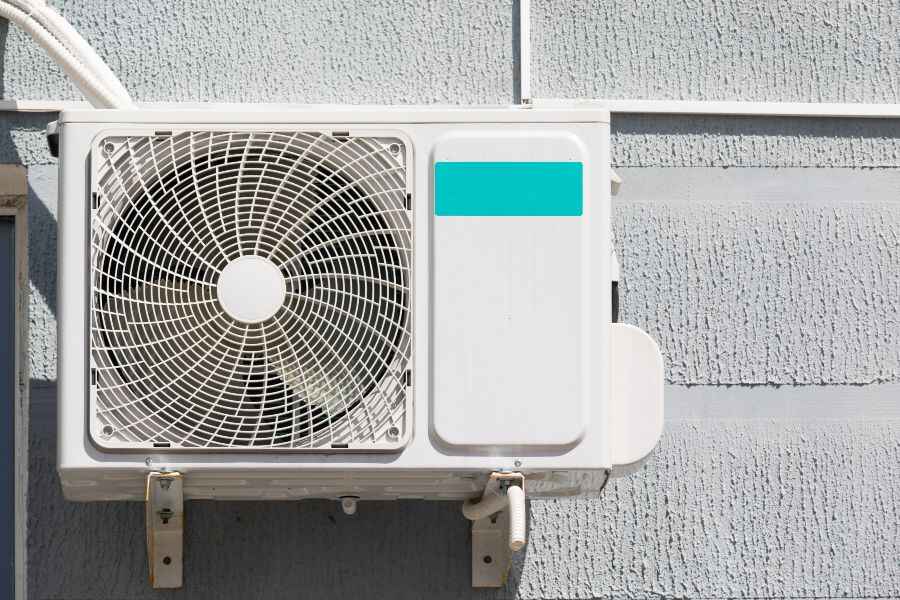
Reverse cycle air conditioners are heat-pump systems that reverse refrigerant flow to deliver cold air in summer and warm air in winter. The outdoor unit pumps refrigerant through copper lines while the indoor air conditioner unit passes air over a coil to absorb or release heat. Available as split-system air conditioners (e.g., wall-mounted units) or ducted systems for whole-home comfort, they’re among the most versatile air conditioning solutions in Australia.
- How they work: In cooling mode, the system recirculates internal air and expels heat via the outdoor condenser unit; in heating mode, it extracts ambient heat outdoors to warm the home.
- Airflow & quality: Good air flow across filters and coils keeps efficiency high. Standard units recirculate air; to bring in fresh air, add mechanical ventilation (some ducted designs integrate it) so you can manage air quality alongside temperature.
- Where they fit: From a single room to whole-home zoning with a ducted air conditioner, reverse cycle covers most air conditioning needs with one cooling system instead of separate heater + air con.
- Buying tip: When choosing a new air conditioner, check capacity, noise, and controls. Reverse cycle is typically installed with Wi-Fi scheduling so you cool/heat only when needed.
VRF/VRV & Multi-Head Split Air Conditioning Systems
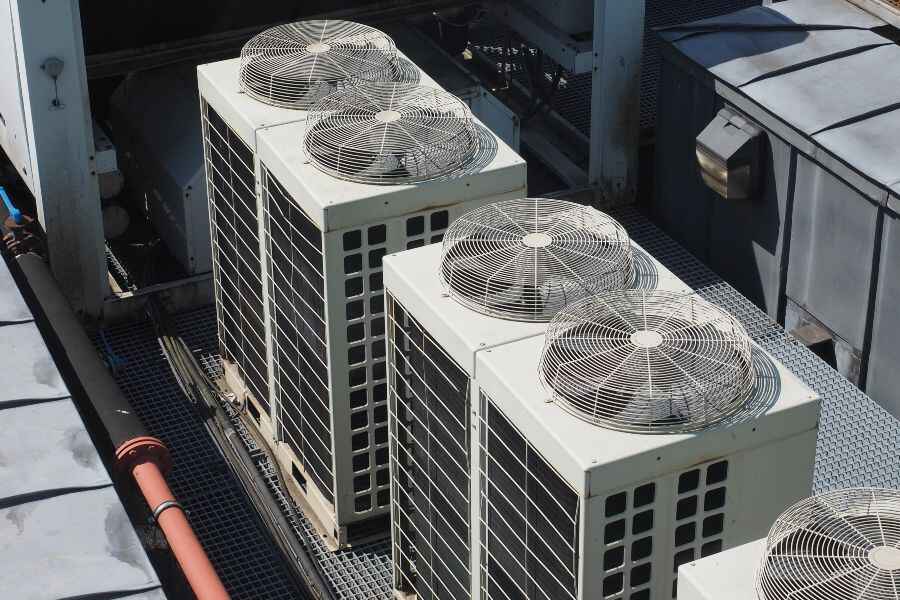
For larger homes and townhouses, Variable Refrigerant Flow/Volume (VRF/VRV) and multi-head split system designs provide advanced zoning. Think of them as multi-split air conditioning that can run multiple air conditioners (indoor units) from a single outdoor unit.
- What you get: One outdoor condenser connects to several indoor units: wall-mounted, floor consoles, slim bulkheads, or cassettes, cooling individual rooms with independent set points. In many installations, only the controller and a discreet grille are visible.
- Why it’s different: Compared with basic multi-split, VRF/VRV precisely meters refrigerant so each room gets just enough to deliver cold air (or heat), even simultaneously in some heat-recovery setups. That means steady comfort and lower running costs across individual rooms.
- Install notes: The outdoor condenser unit is typically installed on a balcony, slab, or roof. Line lengths, height differences, and branching boxes must follow manufacturer limits. This family of systems is sometimes called multi-split air (also “multi split”) and suits renovations where you want many zones without full ductwork.
Design & Installation Essentials (Airflow, Placement, and Fresh Air)
Whichever type of air conditioning unit you choose, performance hinges on design details that determine how well a system delivers cold air.
- Airflow first: Correct fan settings and duct sizing ensure adequate air flow. Poorly sized grilles or blocked filters make an AC noisy and inefficient because less air passes across the coil.
- Indoor placement: A wall-mounted air conditioner should sit high on a clear wall; bulkheads need short, straight ducts; returns mustn’t draw from kitchens or bathrooms. For single room comfort, aim supply air away from occupants to avoid drafts.
- Outdoor clearance: Give the outdoor condenser unit room to breathe; keep it level, shaded, and clear of obstructions so it can reject heat efficiently.
- Fresh vs recirculated: Air conditioners mostly recirculate internal air. If you want fresh air, add dedicated ventilation or consider evaporative cooling in dry climates; these systems move different types of air (outdoor-sourced, humidified air) compared with refrigerant systems.
- Right fit: Match capacity to the space, climate, glazing, and insulation. Oversized units short-cycle; undersized units struggle in heatwaves. This is true for split system air conditioning, ducted air conditioners, and VRF/VRV alike.
These three additions round out the guide so you can compare room-by-room splits, whole-home ducted options, scalable VRF/VRV, and reverse cycle air conditioners, then choose the mix that fits your home and budget.
Whole-Home Comfort, Seamlessly Delivered
We install and service ducted systems around your floor plan, then commission and balance airflow so every room feels just right. – 0480 808 422